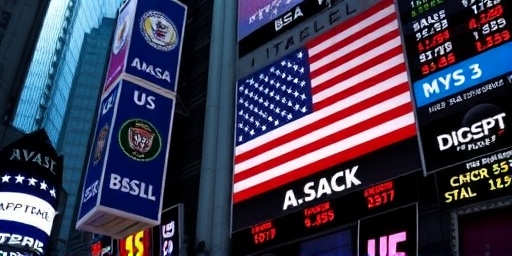Wall Street’s pre-market jitters intensified early Monday as US Stock futures tumbled amid fresh fears over President-elect Donald Trump’s aggressive tariff proposals on imports from key trading partners like China, Mexico, and Canada. Dow Jones futures led the decline, dropping 0.8% or about 300 points, signaling a rocky open for major indices as investors grapple with the potential for a renewed trade war that could disrupt global supply chains and inflate costs for American consumers and businesses alike.
- Dow Futures Spearhead Market Sell-Off on Tariff Uncertainty
- Trump Tariffs Spark Fears of Supply Chain Disruptions
- Investors Brace for Pivotal Economic Data Releases
- Wall Street Analysts Decode Policy Risks and Opportunities
- Global Trade Tensions Escalate as Allies React to US Threats
- Outlook: Markets Navigate Tariff Storm Toward Fed Clarity
Dow Futures Spearhead Market Sell-Off on Tariff Uncertainty
The sharp dip in Stock futures reflects growing apprehension that Trump’s tariff threats—promised during his campaign and reiterated in recent interviews—could escalate into concrete policies once he assumes office in January. S&P 500 futures slid 0.7%, while Nasdaq futures fell 0.9%, erasing some of the post-election gains that had propelled markets to record highs last month. Traders pointed to Trump’s weekend statements on Fox News, where he vowed to impose up to 60% tariffs on Chinese goods and 25% on imports from Mexico, as the primary catalyst for the pre-market rout.
According to data from CME Group, the volume in futures trading surged 20% above average, indicating heightened volatility as institutional investors reposition portfolios. ‘The market is pricing in the worst-case scenario for trade disruptions,’ said Mike Wilson, chief investment officer at Morgan Stanley Wealth Management. ‘Tariffs of this magnitude could add 1-2% to US inflation and shave 0.5% off GDP growth in 2025, per our models.’
Historical precedents underscore the risks: During Trump’s first term, his 2018 tariffs on steel and aluminum triggered retaliatory measures from the EU and China, leading to a 10% correction in the Dow Jones Industrial Average over three months. Today’s Dow Jones futures movement mirrors that unease, with blue-chip stocks like Boeing and Caterpillar—exposed to international trade—seeing the steepest pre-market losses of over 2%.
Trump Tariffs Spark Fears of Supply Chain Disruptions
President-elect Trump’s Trump tariffs rhetoric has zeroed in on protecting American manufacturing, but economists warn of broader ripple effects across sectors. The proposed levies could raise costs for imported components, hitting industries from automobiles to electronics hardest. For instance, the auto sector, which relies on cross-border parts from Mexico under the USMCA trade agreement, faces potential price hikes of 10-15% if tariffs are enacted, according to a report from the Peterson Institute for International Economics.
Retail giants like Walmart and Target, major importers of consumer goods, saw their shares dip in sympathy during after-hours trading Friday, extending losses into Monday’s pre-market. ‘These tariffs aren’t just a tax on foreign producers; they’re a tax on American families,’ noted Kimberly Clausing, an economics professor at the Peterson Institute. She highlighted that during the 2018-2019 trade skirmishes, US households absorbed an average of $419 in additional costs annually.
- Key Affected Sectors: Automakers (e.g., Ford, GM) vulnerable to Mexican supply chains.
- Technology: Apple and semiconductors reliant on Asian imports could see margins squeezed.
- Agriculture: Potential retaliation from China might hammer soybean and corn exports, already down 20% year-over-year.
Market data from Bloomberg shows that the US dollar strengthened 0.3% against a basket of currencies in early Asian trading, as investors flock to safe-haven assets amid trade war fears. This currency shift could further erode competitiveness for US exporters, compounding the tariff impact.
Investors Brace for Pivotal Economic Data Releases
As Stock futures fluctuate, all eyes are on today’s slate of economic indicators, which could either amplify or temper the tariff-induced pessimism. The Institute for Supply Management (ISM) manufacturing PMI, due at 10 a.m. ET, is expected to show a reading of 48.5—still in contraction territory below 50—potentially signaling how trade tensions are already biting into factory activity.
Additionally, November’s construction spending figures and the Federal Reserve’s beige book will provide fresh insights into economic health. ‘If today’s data disappoints, it could push the Fed toward more dovish policy, offering some relief to markets battered by tariff talk,’ opined Krishna Guha, vice chairman at Evercore ISI. The Fed’s next rate decision in December looms large, with odds of a 25-basis-point cut now at 85% on CME FedWatch Tool, up from 70% a week ago.
Recent context adds urgency: US GDP grew at a robust 2.8% annualized rate in Q3, buoyed by consumer spending, but tariff threats risk reversing that momentum. The Conference Board’s leading economic index fell 0.5% in October, its sharpest drop since March 2020, partly attributed to trade policy overhang.
- ISM Manufacturing PMI: A sub-48 reading could trigger further selling in industrials.
- Construction Spending: Expected +0.2% rise; weakness here might highlight residential slowdown.
- Beige Book: Regional anecdotes on trade impacts will guide Fed rhetoric.
Equity options trading volume spiked 15% pre-market, with put-call ratios favoring downside protection, per Cboe data. This defensive posture underscores how Trump tariffs are reshaping investor sentiment just weeks after the election euphoria.
Wall Street Analysts Decode Policy Risks and Opportunities
Analysts across the Street are divided on the net impact of Trump’s trade agenda, with some viewing it as a negotiating tactic and others as a genuine policy shift. Goldman Sachs strategists, in a note Sunday, projected that comprehensive tariffs could reduce S&P 500 earnings by 3-5% in 2025, prompting a 5% market pullback. ‘The tariffs are a double-edged sword—boosting domestic steel but hurting downstream users like appliance makers,’ wrote Lindsay Rosner, a senior economist at the firm.
Conversely, bullish voices like those at RBC Capital Markets argue that Trump’s pro-business stance, including tax cuts and deregulation, could offset tariff drags. ‘Look beyond the headlines; his first term saw the Dow rise 50% despite trade wars,’ said Lori Calvasina, head of US equity strategy at RBC. She forecasts the index hitting 45,000 by mid-2025 if tariffs are implemented gradually.
Quote from market veteran Jim Cramer on CNBC: ‘Trump’s tariffs are like a bull in a china shop—exciting for some, disastrous for others. But markets hate uncertainty more than anything.’ This sentiment is echoed in volatility metrics, with the VIX futures up 4% to 18.5, approaching levels seen during the 2018 trade spat.
Sector-specific forecasts vary: Energy stocks, buoyed by Trump’s ‘drill baby drill’ promises, bucked the trend with modest gains in pre-market trading. Meanwhile, the Russell 2000 small-cap index futures dropped 1.1%, as smaller firms with thinner margins face acute tariff pressures.
International markets offered no respite, with Asian indices like the Nikkei down 0.5% and Europe’s Stoxx 600 opening lower by 0.4%, both citing US policy risks. The Hang Seng in Hong Kong fell 1.2%, hit by direct exposure to Chinese exports.
Global Trade Tensions Escalate as Allies React to US Threats
Beyond domestic markets, Trump’s tariff blueprint is straining alliances. Canadian Prime Minister Justin Trudeau warned over the weekend of ‘serious consequences’ if 25% duties on Canadian autos and lumber proceed, potentially unraveling USMCA provisions. Mexico’s economy minister echoed similar concerns, noting that bilateral trade tops $800 billion annually.
In Europe, the European Commission is preparing countermeasures, with tariffs on US whiskey and motorcycles under consideration—tit-for-tat moves that hark back to 2018. ‘A full-blown trade war could cost the global economy $1 trillion in lost output,’ estimated the IMF in a recent update, with the US bearing 40% of the burden through higher prices and slower growth.
China, Trump’s primary target, has remained stoic but signaled readiness to retaliate. Beijing’s commerce ministry stated that ‘unilateral tariffs violate WTO rules and will harm all parties.’ US agricultural exports to China, already reeling from prior disputes, could plummet another 30% if escalations occur, per USDA projections.
Corporate leaders are mobilizing: The US Chamber of Commerce urged moderation in a letter to Trump, arguing that tariffs could eliminate 2.6 million jobs. Tech lobbyists from Silicon Valley, including Meta and Google, highlighted risks to innovation from disrupted semiconductor flows.
Outlook: Markets Navigate Tariff Storm Toward Fed Clarity
Looking ahead, the trajectory of stock futures and the broader Dow Jones will hinge on how Trump’s team fleshes out tariff details in coming weeks. Incoming Treasury Secretary nominee Scott Bessent has hinted at a phased approach to avoid market shocks, but uncertainty persists until inauguration.
Investors are also monitoring congressional dynamics; with Republican majorities, tariff legislation could pass swiftly, though Senate moderates like Susan Collins have voiced reservations. The December Fed meeting and January jobs report will be critical litmus tests for economic resilience amid policy flux.
In the near term, strategists recommend diversification into tariff-resilient assets like Treasuries and gold, which rose 0.5% pre-market. Long-term, if tariffs catalyze domestic investment as proponents claim, sectors like infrastructure and reshoring could thrive, potentially lifting the Dow to new highs by year-end 2025. Yet, the path forward remains fraught, with today’s data releases poised to set the tone for a volatile December on Wall Street.









